#168 Forty years of making room
Making Room: Forty Years of Room Magazine
by Meghan Bell (editor) and curated by the Growing Room Collective: Meghan Bell, Terri Brandmueller, Candace Fertile, Taryn Hubbard, Chelene Knight, Lindsay Glauser Kwan, Cara Lang, Alissa McArthur, Navneet Nagra, Bonnie Nish, Rachel Thompson, Kayi Wong, and Lisa Xing
Halfmoon Bay: Caitlin Press, 2017
$24.95 / 9781987915402
Reviewed by Megan Davies
First published Sept. 11, 2017
*
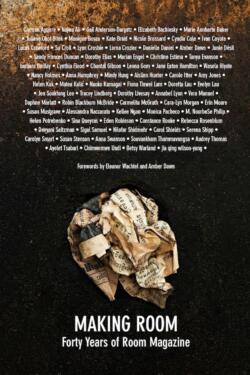 Holding the 416-page heft of this volume gives me the certain knowledge that I am a shareholder in an impressive collective cultural history. And no wonder, for the anthology Making Room connects the reader to a deeply authentic selection of Canadian feminist poetry, short fiction and memoir drawn from the pages of the Vancouver magazine Room over its forty years of publication.
Holding the 416-page heft of this volume gives me the certain knowledge that I am a shareholder in an impressive collective cultural history. And no wonder, for the anthology Making Room connects the reader to a deeply authentic selection of Canadian feminist poetry, short fiction and memoir drawn from the pages of the Vancouver magazine Room over its forty years of publication.
Founded in 1975 as Room of One’s Own — an evocation of Virginia Woolf’s famous dictum that women need freedom and unfettered space to nurture their own creativity, Room has more than lived up to its name.
The magazine published pieces in its early years that made other CanLit journals uneasy: poems like Cyndia Cole’s searing “No Rape. No” would not have appeared elsewhere in this period, nor from The Cancer Year, a brave and beautiful photographic essay on mastectomy by Dorothy Elias and barbara findlay.
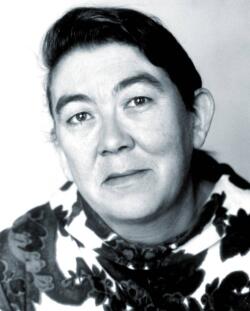
Room introduced Québécois feminist literature to the rest of Canada in 1979. And the evolving journal collective has struggled, and had some success, with the on-going project of ensuring that the feminist canon is inclusive, first by intentionally including writing by Indigenous women, Black women, East-Asian and Asian women, disabled women, LGBTQA+ and 2S women, and then by opening the door to authors who are transgender or non-binary.
Room was born out of the sense of extreme urgency and heady possibility that moved Canadian feminists in the mid-1970s. Internationally, publications like Ms Magazine (US) and Spare Rib (UK) were rolling off the press and major female authors like Margaret Drabble and Doris Lessing were publishing work that made the material and emotional lives of women central to their story. In English Canada, Margaret Lawrence, Alice Munro, Audrey Thomas, Jane Rule, and Dorothy Livesay claimed a feminist voice and sold a lot of books.
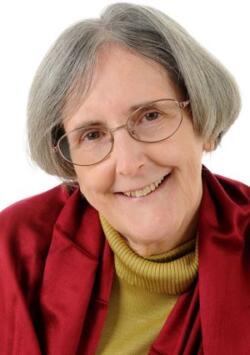
The four women who formed the genesis of Room’s first collective lived in a city where a vibrant feminist community grew to include a women’s health centre, a feminist newspaper, a women’s bookstore, a women’s press, and many other organizations, businesses and structures that supported women. Crucially, stable funding was available. The collective, still Room’s operational structure, was the norm in feminist circles of the era.
“I felt I was exactly at the centre of the life I most wanted,” recalled founder Gayla Reid.
Because I am a women’s historian I looked at this volume as a rich cultural archive of Canadian feminism, each chapter a cultural time capsule containing a handful of published pieces and the text of a past/present collective member conversation. I tried to mine the writing and interview transcripts from each of the four decades for insights about the evolution of the “ism” that has defined my adult life.
The interview and prose selections from 1975-1987 are infused with the liberation of women — difficult, necessary and joyful — and short fiction and poetry deals with violence, motherhood, identity formation, and bonds among women.
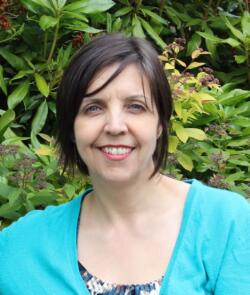
Between 1988 and 1997 the themes are similar, but here I see a poem about incest and a short story about a lesbian relationship, and the conversation coming out of the interview is more self-critical, citing good intentions but limited diversity at Room.
A more noticeable shift comes in the 1998-2007 chapter. The section opens with a set of poems addressed to women murdered at École Polytechnique in Montreal, but apart from those and a poem about racism and violence, I struggled to situate the rest of the excellent pieces within a feminist canon, even after a swim and a late-night re-read.
Reevaluating the accompanying interview with former collective member Lana Okerland, I understood these writings as coming out of the difficult period when calling yourself a feminist was socially suspect, kind of like being caught recycling your socks for a third day. Okerland describes how criticism from Canada Council and former collective members prompted an identity crisis for Room in the early 2000s, when it was even suggested that the magazine disassociate itself from the word “feminist.”
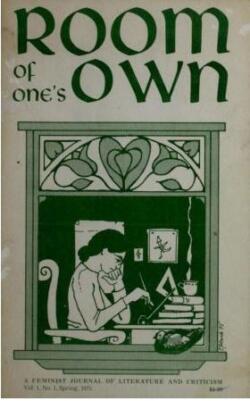
The resulting 2007 rebranding brought a new (and delightfully expansive) name, an overdue entry into the world of twenty-first century technology, and — most importantly — a decision to stop playing safe and take on important, relevant work. “We wanted the magazine to move forward and initiate conversation and literally give writers and readers the room for that dialogue,” Okerland recalled.
This bold move may have been why Room survived when so many other feminist publications vanished. “Pushing feminism to be more,” meant keeping the organization flexible so it could respond to change and opportunity, making diversity not just theory but praxis, and embracing intersectional feminism alongside humour and surprise.
Reading the pieces in the final chapter, which covers the years 2008-2016, kept my feminist mind alert for these elements. The cleverly structured “River Phoenix Social Club,” with an uppity group of rape victims opting for collective action instead of solitary passivity, might have been published thirty years earlier, except that the ending doesn’t provide a clear moral message.
 In the dark fantasy of the poem “Maheen’s Collage,” an Iranian mother carves up the bodies of her two young daughters, selecting the finest eyes and the flattest belly, to make one perfect Persian bride. In the 1970s or 1980s, I suspect, the main character of this piece would have been a blond Barbie doll or perhaps Jane Fonda.
In the dark fantasy of the poem “Maheen’s Collage,” an Iranian mother carves up the bodies of her two young daughters, selecting the finest eyes and the flattest belly, to make one perfect Persian bride. In the 1970s or 1980s, I suspect, the main character of this piece would have been a blond Barbie doll or perhaps Jane Fonda.
Social justice literary forums like Room take the power of the personal voice and amplify it, providing crucial venues for creative output from often-marginalized artists. The past/present conversations in this volume provide rich insights into what involvement with a collective meant to members, but I wish I knew more about the authors whose names do not bring ready recognition. Did seeing their work in print for the first time bring the same amazed pride that I recall from my first undergraduate publication? Did publishing in Room open the door to continued work as an author and a new creative identity?
 I didn’t notice that feminism had become acceptable again until women all over the world took to the streets to demonstrate on January 21, 2017. “I want to talk with you,” a woman said to my 24-year-old daughter at a recent party, “because you were a feminist before it was cool to be one.”
I didn’t notice that feminism had become acceptable again until women all over the world took to the streets to demonstrate on January 21, 2017. “I want to talk with you,” a woman said to my 24-year-old daughter at a recent party, “because you were a feminist before it was cool to be one.”
So here is the gift that this book gives: it makes it 150% clear why being a feminist in the twenty-first century isn’t just cool. It is about feminisms, plural, and operating with a clear appreciation for the privilege that race, health, age, and economic position offer. It is about taking and holding female power in a fashion that includes all who claim that descriptor. It is about being ready, always, to march for the right to control your body.
And it is about finding the female — the woman on the bus, your best friend, yourself — on the cinema screen, in the novel you are reading, and the poem you see pasted up on the subway. As this wonderful anthology makes clear, feminism is a toolkit for survival.
Happy 40th Room, and thank you.
*
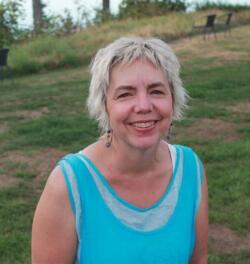
Megan Davies was a founding editor at The Emily (now Third Space Story), a feminist student newspaper which began publication at the University of Victoria’s Women’s Centre in the early 1980s. A B.C. historian based at York University, she researches and writes on madness, old age, food, and rural health.
*
The Ormsby Review. More Books. More Reviews. More Often.
Publisher and Editor: Richard Mackie
The Ormsby Review is a journal service for in-depth coverage of BC books and authors in all fields and genres. The Advisory Board consists of Jean Barman, Wade Davis, Robin Fisher, Cole Harris, Hugh Johnston, Kathy Mezei, Patricia Roy, Maria Tippett, and Graeme Wynn. Scholarly Patron: SFU Graduate Liberal Studies. Honorary Patron: Yosef Wosk. Provincial Government Patron since September 2018: Creative BC
“Only connect.” – E.M. Forster
The Ormsby Review. More Readers. More Reviews. More Often.